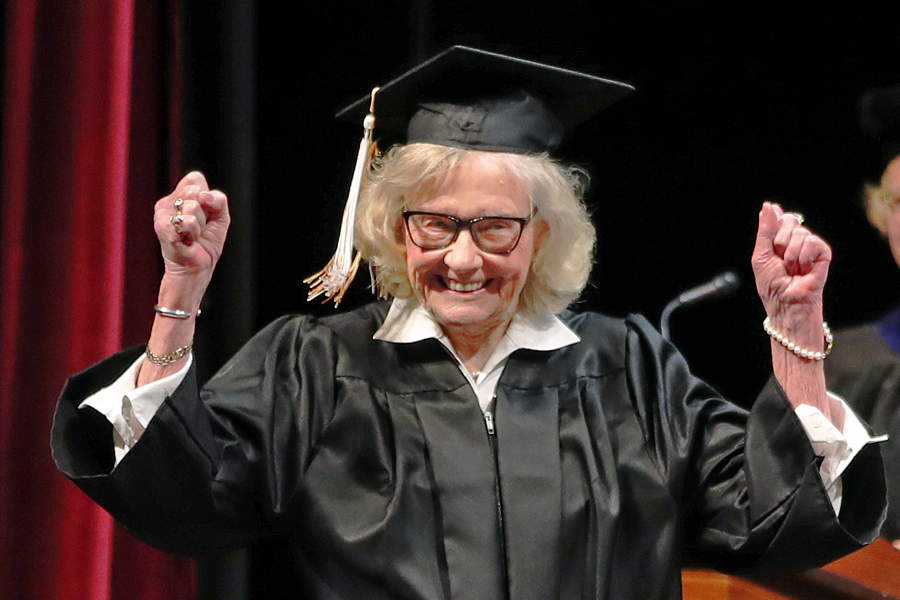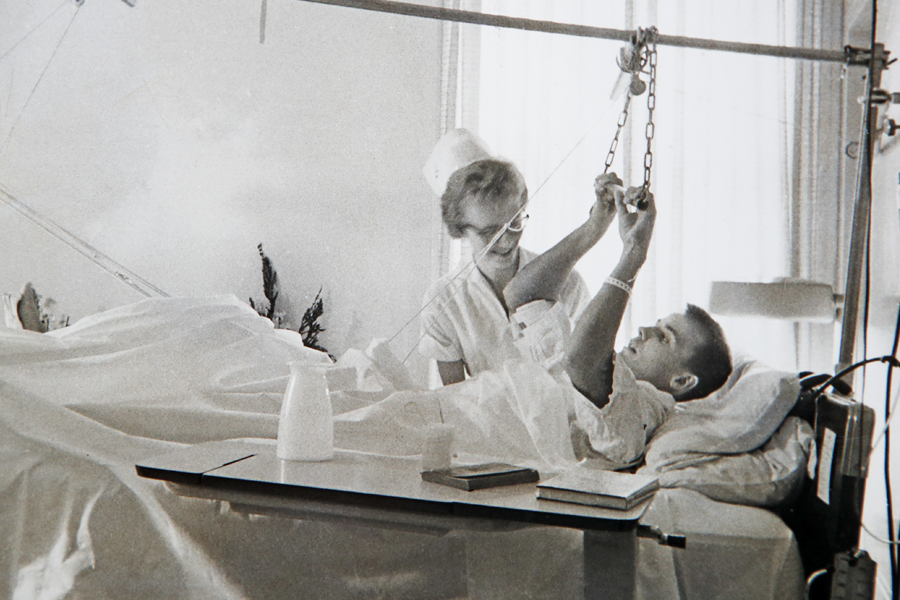
On May 7, Betty Sandison strolled across the stage at Northrop, joy lighting up her face, to receive her bachelor’s degree. Seven days earlier, Sandison celebrated her 84th birthday. That’s a nice little run of weekend celebrations.
For Sandison, who received a bachelor’s degree in Multidisciplinary Studies from the College of Continuing and Professional Studies (CCAPS), getting her diploma was more about completing a journey than preparing for an encore career, but it crystalizes the value she places on education—for folks of all ages.
“My big thing is, I would like to encourage older people to go to classes, to keep learning, and not just sit in front of the TV,” Sandison says.
She’s certainly done a lot more than that.
From one room to one really big school
Sandison grew up on a farm near Renville, a small town in southwest Minnesota. Through the third grade she went to a one-room schoolhouse with about a dozen other kids—“kind of all related,” she laughs.
She worked for three summers at Randy’s Cafe in town serving hamburgers, fries, milkshakes, and the like. (Coffee, donuts, and ice cream cones were a nickel apiece.)
When she completed high school in 1955 she decided to strike out to the University of Minnesota to become a nurse, even though no one else in her family had attended college. “Back in those days you were either a nurse or a teacher or a secretary,” she says. “Those were the choices.”
The $600 she managed to save from the cafe was enough to pay for her whole year at the U, and the following spring, as a licensed practical nurse, she began working in neurology at the University hospital. A year later she was back at the U of M with thoughts of becoming an elementary school teacher, but soon after she put her career on hold to support her future husband’s career and raise a family. The couple had two girls and spent time living in both Chicago and Detroit.
When the marriage dissolved in 1979, Sandison returned to nursing at St. Joseph’s Hospital in St. Paul. She attended Lakewood Community College in an advanced program to become an RN and graduated two years later. Then came a three-decade career in nursing across many units and a number of states. She was a travel nurse in Florida and California.
In spring 2018, Sandison was at lunch with friends talking about dreams and bucket lists. She mentioned her desire to return to school to finish up her bachelor’s degree, and a friend said, “What’s stopping you?” she says. “And I really didn’t have an answer.”
Sandison is quick to credit her two CCAPS advisors—first Karolyn Redoute and then Karen Moon. Moon is full of praise in return, and knows it’s tough for anyone to return to school, let alone someone who started in the Eisenhower administration.
“The further you’re away from college and writing papers and navigating the hierarchy of academia, it just becomes really intimidating,” says Moon.
For Sandison, it meant leaping into an era defined by technology and computers; making the jump from paper printouts to email attachments. “She was game for anything,” Moon says. “She was going for IT help—sitting down with people and learning the technology. … If there was some knowledge gap or skills gap, she was going to address that early.”
Campus culture, then and now
With her time as a Gopher spaced out over eight decades and ten U of M presidents, Sandison has seen the campus grow and transform. In 1955 Coffman Memorial Union was just 15 years old and still hosting dances in the ballroom. Temporary buildings from the post-WWII era dotted the campus. The West Bank? It didn’t exist.
Sandison lived in Sanford Hall that first year and recalls eating three meals a day there, socializing with friends, and going to church on Sundays.
One of her roommates at Sanford eloped. But, she recalls, “We couldn’t say anything because if they found out in the nursing school she’d get kicked out of the program!”
People didn’t get around on campus by car or bike, so “I walked a lot,” she says. And, “I couldn’t get over how many people smoked.”
Six and a half decades later, the U is now a smoke-free campus. There are definitely cars and bikes, and she’s managed to avoid any incidents with the latter. Smartphones are ubiquitous, but they’re worlds away from the party line she knew as a kid. (See “party line” on Wikipedia.)
“This is a whole different world than what I grew up in,” she says. But she loved her classmates. “Students have been very helpful and very pleasant,” she says. “They make you feel good.”
An ace student in the digital age
While college wasn’t easy for Sandison in the ’50s—there were quite a few Bs and below in her paper transcript—she excelled this time around. Standing alone in a litany of As and A-minuses is a lone B+, for a course she figured would be a breeze: a history class covering 1945 to the present.
“I was alive for the whole time,” she smiles, but “that was the hardest course I took. I didn’t realize how many things had happened in that time.”
Like the start and finish to Sandison’s undergraduate years.
“I’m going to be lost,” she says. “This has been a big thing; it’s been important to me.” She pauses. “I think I may come back and audit some classes. … I don’t feel like [college is] something that’s going away.”






